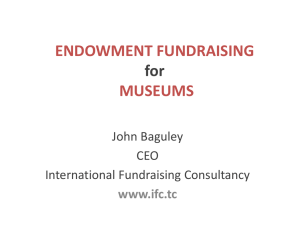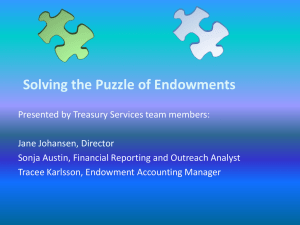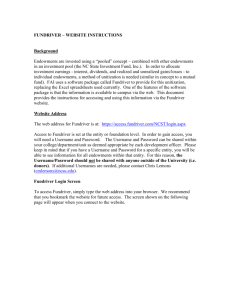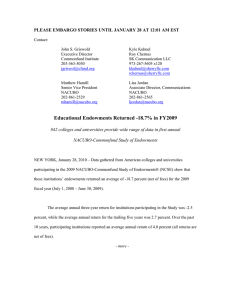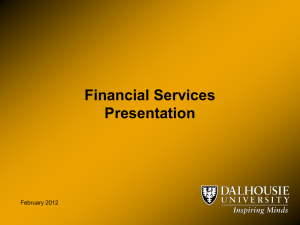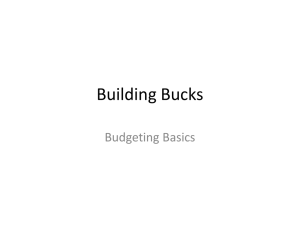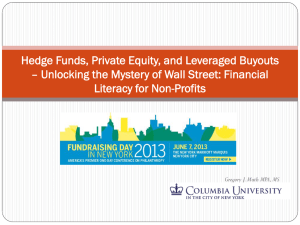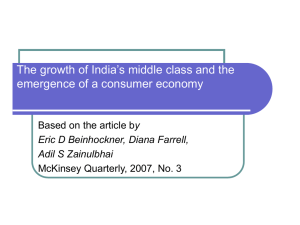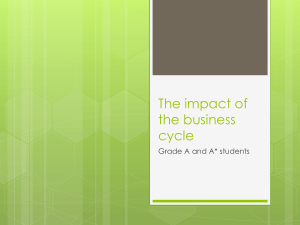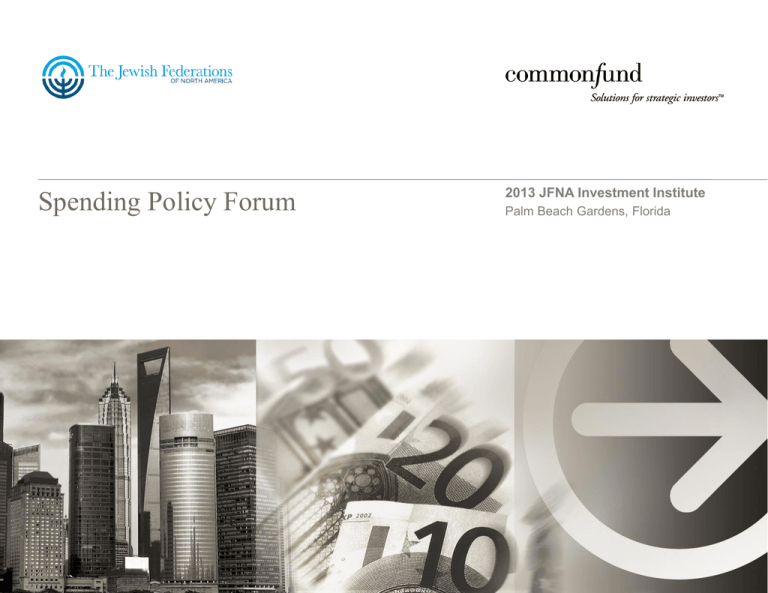
Spending Policy Forum
2013 JFNA Investment Institute
Palm Beach Gardens, Florida
Policy Development Example | Spending Policy Approaches
Approach
Description
Traditional
Pre-specified percentage of moving average of market value – typically 5% of a three year moving
average of beginning market values
Inflation Based
Increase spending each year based on rate of inflation
Income Based
Spend all current income
Banded Inflation
Last year’s spending plus an inflation rate, but bound by ranges, e.g. – no more than 6.5% nor less than
3.5%
Spending Reserve
Segregation of 5-10% of market value in separate account, invested in 90 day treasury bills. Reserve is
drawn down when endowment performance is less than policy target
Stabilization Fund
A fund created from endowment returns in excess of the target spending rate which is used to control the
long run growth of the total endowment. The stabilization fund is invested alongside the endowment, but
with a different (higher) spending rate.
“Yale Rule”
The amount released under the spending rule is based on a weighted average of prior spending adjusted
for inflation (80 percent weight) and the amount that would have been spent using 5 percent of current
Endowment market value (20 percent weight).
“Stanford Rule”
2
February 12, 2013
The calculation is an average weighted 60% on the actual payout from the current year and 40% on the
target payout rate. This policy results in a “smoothing” of the payout amount, and it is designed to
cushion the university from swings in the yearly endowment value due to market fluctuations.
2013 JFNA Investment Institute | Palm Beach Gardens, FL
Effective Spending Rate
By Fiscal Year
Education
Foundations
Spending Rate (%)
Operating Charities
5.9%
5.8%
5.8%
5.6%
5.5%
5.5%
5.5%
5.5%
5.5%
5.1%
4.7%
5.1%
4.9%
4.8%
4.7%
4.6%
4.6%
4.4%
4.3%
FY 2005
FY 2006
FY 2007
FY 2008
4.6%
4.5%
FY 2009
FY 2010
4.2%
FY 2011
FY 2012
NOTE: All performance information reflects net total returns. Fiscal year end for the majority of educational institutions is June 30th. For the foundations
and operating charities sectors fiscal year end is typically December 31st. Information for educational endowments is drawn from the NACUBOCommonfund Study of Endowments. Information for other sectors is drawn from the Benchmarks Study for the respective sectors. Copyright 2013 The
Common Fund for Nonprofit Organizations and the National Association of College and University Business Officers. All rights reserved.
3
February 12, 2013
2013 JFNA Investment Institute | Palm Beach Gardens, FL
Spending Policy
Educational
Endowments Foundations
Top
Quartile
Total
Top
Quartile
Total
Top
Quartile
66%
47%
42%
72%
50%
8%
6%
5%
6%
6%
4.7%
5.1%
5.1%
5.1%
5.0%
11%
14%
20%
19%
19%
25%
*
0%
1%
0%
3%
0%
4%
6%
6%
12%
1%
0%
4.7%
5.0%
4.9%
1.0%
*
Total
Percentage of a moving average 75%
Spend all current income
4%
Average percentage 4.7%
Decide on an appropriate rate each year
Grow distribution at a predetermined inflation rate
Spend a pre-specified percentage of beginning market rate
Operating
Charities
Average pre-specified percentage spent 4.8%
Last year's spending plus inflation with upper and lower bands
4%
5%
1%
2%
6%
6%
Weighted average or hybrid method (Yale/Stanford Rule)
7%
8%
2%
2%
9%
13%
*
*
50%
56%
0%
0%
8%
11%
9%
12%
9%
6%
Meet IRS minimum of 5 percent
Other
* Less than 1 percent, results not meaningful or not applicable.
NOTE: All performance information reflects net total returns. Fiscal year end for the majority of educational institutions is June 30th. For the foundations,
operating charities and healthcare sectors fiscal year end is typically December 31st. Information for educational endowments is drawn from the
NACUBO-Commonfund Study of Endowments. Information for other sectors is drawn from the Benchmarks Study for the respective sectors. Copyright
2013 The Common Fund for Nonprofit Organizations and the National Association of College and University Business Officers. All rights reserved.
4
February 12, 2013
2013 JFNA Investment Institute | Palm Beach Gardens, FL
Important Notes | Market Commentary
Information, opinions, or commentary concerning the financial markets, economic conditions, or other
topical subject matter are prepared, written, or created prior to printing and do not reflect current, up-todate, market or economic conditions. Commonfund disclaims any responsibility to update such
information, opinions, or commentary.
To the extent views presented forecast market activity, they may be based on many factors in addition to
those explicitly stated in this material. Forecasts of experts inevitably differ. Views attributed to third
parties are presented to demonstrate the existence of points of view, not as a basis for recommendations
or as investment advice. Managers who may or may not subscribe to the views expressed in this material
make investment decisions for funds maintained by Commonfund or its affiliates. The views presented in
this material may not be relied upon as an indication of trading intent on behalf of any Commonfund fund,
or of any Commonfund managers.
Market and investment views of third parties presented in this material do not necessarily reflect the views
of Commonfund and Commonfund disclaims any responsibility to present its views on the subjects
covered in statements by third parties.
5
February 12, 2013
2013 JFNA Investment Institute | Palm Beach Gardens, FL
Important Disclaimer
Use Of This Presentation
This presentation is copyrighted by Commonfund; all rights reserved. While
you may copy it for your personal use, you are not permitted to publish,
transmit, or otherwise reproduce this presentation, in whole or in part, in any
format to any third party without the express written consent of
Commonfund. In addition, you are not permitted to alter, obscure, or
remove any copyright, trademark or any other notices that are provided to
you in connection with this presentation
6
February 12, 2013
2013 JFNA Investment Institute | Palm Beach Gardens, FL
Controlled Growth Distribution Policy
•
Jewish Federation of Metropolitan Chicago
Unrestricted Endowment Distribution Policy
o Target distribution = 2.5% more than prior year
o Adjustments will be made to ensure that …
• … distribution equals 4% to 7% of assets …
• … this notwithstanding, year-over-year change must fall
within range of +8% to –4%
o Additional risk controls:
• No increase – in dollars or as % of assets – allowed in year
following a distribution cut
CGDP Flowchart
Under “normal” conditions …
For existing endowments
baseline is previous
year’s distribution
For new endowments
baseline is set at 5.5%
of assets
… distribute 2.5% more than previous year
as long as distribution falls within 4-7% of assets
If the normal increase would cause the
distribution to fall above or below 4-7% of
assets …
… raise distribution to 4% of
assets, unless:
… reduce distribution to 7% of
assets, unless:
If distributing 4% of assets would require
raising the distribution by +8% or more
from the prior year …
… increase distribution
by +8% above previous
year
… that the distribution
cannot go up (in dollars or %
of assets) in any year
following a cut
If distributing 7% of assets would require
cutting the distribution by -4% or more
from the prior year …
Subject to the
requirement …
… reduce distribution
by -4% below previous
year …
CGDP Objectives
•
Greatly improve payout consistency
o Budget focused distribution policy based on dollar amount, not percentage
o Greatly reduced market dependence – eliminates “feast or famine” reliance
on market performance
o Distributions grow steadily in real terms - targeted annual increases with limits
o Limits frequency and severity of distribution cuts
•
Balance tensions between long- and short-term objectives
o Growing endowment assets is a long-term process
o Managing budgetary needs is a short-term process
•
Key Benefits:
o More predictable distributions
o Less year-to-year variability
o Endowment assets growing in real terms rather than shrinking
o Larger distributions over very long run
Joseph in Egypt Revisited
Navigating Fat Years and Lean Years
Pro Forma Distributions and Assets
5% Moving Average vs. CGDP
(Hypothetical 60/40 Portfolio)
$250
$10
$9
$8
$150
$6
$5
$100
$4
$3
$50
$2
$1
MovAve Distribution
CGDP Distribution
MovAve Assets
CGDP Assets
2012
2011
2010
2009
2008
2007
2006
2005
2004
2003
2002
2001
2000
1999
1998
1997
1996
1995
1994
1993
1992
1991
1990
1989
1988
1987
1986
1985
1984
1983
1982
1981
$0
1980
$0
1979
Assets ($million)
$7
Distribution ($million)
$200
‘Steady State’ (Smooth Spend-Down)
Endowment
Outlays
Barriers to ‘Replacement’ Funding
‘Branding’
Lack of Alternatives
Grantee Dependency
‘Big Finish’ (Large Terminal Grants)
Endowment
Outlays
‘Big Start’ (Major Initial Grants)
Endowment
Outlays
From the Beginning, Think About Ending
Can the Mission Be Completed?
If Not, Can It Be Carried On
When You’re Gone?
What Resources Will You Need at
the End to Ensure Success?



